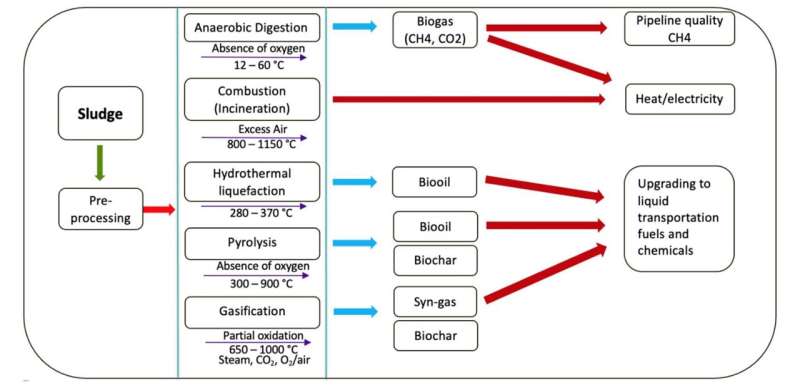Tapping the potential of wastewater for a sustainable future

It might seem an unlikely partnership, but sewage sludge has a role in a clean energy future.
A bioproduct of wastewater treatment plants, sewage sludge emits methane, a potent greenhouse (GHG) gas that drives climate change. Methane can be captured and used to produce renewable natural gas (RNG) or generate renewable electricity for the plant's on-site energy needs. This process reduces the plant's production costs and avoids methane emissions.
Wastewater also contains valuable nutrients like nitrogen and phosphorus that can be captured and recycled as fertilizer. The water itself can be treated and reused as fresh water.
Most wastewater treatment plants do not currently capture these valuable resources for reuse. Nevertheless, there is significant potential for reaping their benefits, according to scientists at the U.S. Department of Energy (DOE) Argonne National Laboratory.
"It is a gradual shift, but more wastewater treatment plants are recognizing that capturing these resources could provide revenue to offset their own production costs and help meet sustainability goals," said Troy Hawkins, Argonne's Fuels and Products group manager.
Argonne scientists published a new report assessing the potential for recovering these resources from the roughly 15,000 U.S. municipal wastewater plants. Scientists hope to increase the use of resource recovery technologies in the U.S.
Researchers also examined how the potential for capturing these resources varies by region and assessed potential markets.
Results show that most wastewater resources are produced by very large treatment plants and that some resources can be redistributed based on the needs of specific regions. The study also shows that recovering wastewater resources is effective in curbing GHG emissions.
Argonne data set aids wastewater resource recovery
Scientists began by creating a comprehensive data set of all wastewater treatment facilities in the U.S. and assessing the resource recovery potential for each. The team drew on key publications and resources to create the data set.
"Argonne's unique contribution was to develop a comprehensive data set of wastewater treatment facilities and apply these recovery technologies to each facility to assess the potential for recovering resources," Hawkins said. "We compared these against a baseline facility that does not use these technologies."
The team studied three recovery technologies: anaerobic digestion with a flare to convert the methane in biogas to carbon dioxide, a less powerful greenhouse gas; anaerobic digestion to produce RNG, and hydrothermal liquefaction to produce renewable diesel.
The report shows that most wastewater resources are produced by very large treatment plants processing more than 5 million gallons a day. Yet, these facilities make up only 8% of total treatment plants.
Researchers found that 77% of the total energy, water, and nutrients in wastewater flow is produced at these very large wastewater treatment plants.
This finding suggests that initial investments to recover resources from wastewater could focus on a smaller number of large treatment facilities while still capturing most of the available resources in wastewater.
Currently, anaerobic digestion is the most used technology for energy recovery. Ten percent of treatment facilities use anaerobic digestion technology, the report shows. These facilities can use this existing technology to produce RNG or electricity. Wastewater facilities that recover energy generally use the biogas to generate electricity.
Wastewater resources across the U.S.
Because the wastewater industry varies significantly across the U.S., the team examined how the potential for capturing resources varies by region.
For example, the demand for irrigation is higher in states like California or Arizona where water is in short supply. Demand for nitrogen to make fertilizer is higher in the Upper Midwest, California and Florida where large-scale agriculture is prevalent.
Results show that some resources can be redistributed based on the needs of specific regions, said lead author Miae Ha, a former Argonne research scientist who is now a scientist at Delphinus Engineering, Bethesda, MD.
"Our study details fertilizer demand and potential production at the county level," said Ha. "Where supply exceeds demand, counties or states could distribute nutrient products to those areas where they are needed."
Large wastewater treatment plants are generally located near large cities, which offer markets for their products. Two-thirds of the RNG potential from large wastewater treatment facilities is located less than 5 miles from a natural gas pipeline network. One-quarter of the RNG potential is located less than a mile from a natural gas pipeline network.
"This means that large wastewater treatment facilities could leverage existing infrastructure to transport renewable natural gas to the market," Hawkins said.
Recovery technologies help reach environmental goals
Recovering resources from wastewater is also effective in curbing GHG emissions to help meet federal climate change goals.
Scientists used Argonne's GREET, Greenhouse Gases, Regulated Emissions, and Energy Use in Technologies model to calculate lifecycle GHG emissions for recovery technologies studied in the report.
"Our calculations found that lifecycle GHG emissions for RNG from anaerobic digestion or renewable fuel from hydrothermal liquefaction can support DOE's Better Climate Challenge. This supports President Biden's goal of a net-zero emissions economy by 2050," Ha said.
The DOE's Better Climate Challenge is challenging organizations to set ambitious, portfolio wide GHG emission reduction goals.
These technologies could be further advanced to capture methane emissions from animal manure and food waste.
While recovery technologies tie directly to federal emissions goals, challenges remain to widescale adoption. Economic barriers are a major hurdle.
Argonne scientists hope the report will spur stakeholders to tap into the technology's large potential for resource recovery.
"The challenge is getting these technologies to be cost-competitive, and they are not quite there yet," Hawkins said. "I anticipate these technologies will move quickly in the coming years as the efforts to decarbonize the economy are ramped up."
More information: Miae Ha et al, Opportunities for Recovering Resources from Municipal Wastewater, OSTI.gov (2022). DOI: 10.2172/1876441
Research data: greet.es.anl.gov/publication-recovery_from_mww


















